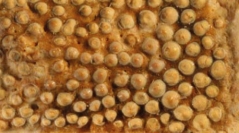

 Comptes Rendus Palevol
10 (5-6) - Pages 427-437
Comptes Rendus Palevol
10 (5-6) - Pages 427-437The Glyptosaurinae, a fossil clade of anguid lizards, have robust osteoderms, with a granular ornamentation consisting of tubercles. In this study, the structural and histological features of these osteoderms are described in order to reconstruct their developmental pattern and further document the possible homology that could exist between vertebrate integumentary skeletons. Glyptosaurine osteoderms display a diploe architecture and an unusually complex structure that includes four tissue types: an intensely remodeled core of woven-fibered bone, a thick basal layer of lamellar bone, a peripheral ring exhibiting histological features intermediate between these two tissues and containing dense bundles of long Sharpey fibers, and a superficial layer made of a monorefringent, acellular and highly mineralized material, different from bone, and comparable in many respects to hypermineralized tissues such as ganoine, enameloids and enamel. We call this tissue osteodermine. The growth pattern of glyptosaurine osteoderms is likely to have involved first metaplasia, at an early developmental stage, then appositional growth due to osteoblast activity. The superficial layer that is well developed at the tubercle level must have resulted from epidermal and dermal contributions, a conclusion that would support previous hypotheses on the role of epidermal-dermal interactions in the formation of squamate osteoderms.
Squamates, Osteoderms, Metaplasia, Bone, Hypermineralized tissue, Histology, Scanning electron microscope (SEM)